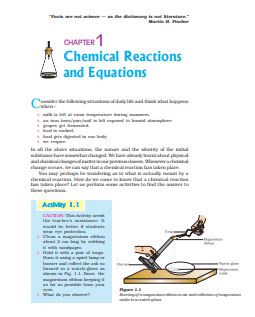‘NCERT Solutions for Class 10 Science Chapter 1‘ PDF Quick download link is given at the bottom of this article. You can see the PDF demo, size of the PDF, page numbers, and direct download Free PDF of ‘Ncert Class 10 Science Chapter 1 Exercise Solution’ using the download button.
NCERT Class 10 Science Textbook Chapter 1 With Answer PDF Free Download

Chapter 1: Chemical Reactions And Equations
1.1 Chemical Equations
Activity 1.1 can be described as – when a magnesium ribbon is burnt in oxygen, it gets converted to magnesium oxide.
This description of a chemical reaction in sentence form is quite long. It can be written in a shorter form. The simplest way to do this is to write it in the form of a word-equation.
The word-equation for the above reaction would be – Magnesium + Oxygen → Magnesium oxide (1.1) (Reactants) (Product) The substances that undergo chemical change in the reaction (1.1),
magnesium and oxygen, are the reactants. The new substance, magnesium oxide, formed during the reaction, is the product.
A word-equation shows change of reactants to products through an arrow placed between them. The reactants are written on the left-hand side (LHS) with a plus sign (+) between them.
Similarly, products are written on the right-hand side (RHS) with a plus sign (+) between them. The arrowhead points towards the products, and shows the direction of the reaction.
1.1.1 Writing a Chemical Equation
Is there any other shorter way of representing chemical equations? Chemical equations can be made more concise and useful if we use chemical formulae instead of words.
A chemical equation represents a chemical reaction. If you recall formulae of magnesium, oxygen and magnesium oxide, the above word-equation can be written as – Mg + O2 → MgO (1.2)
Count and compare the number of atoms of each element on the LHS and RHS of the arrow. Is the number of atoms of each element the same on both sides?
If not, then the equation is unbalanced because the mass is not the same on both sides of the equation.
Such a chemical equation is a skeletal chemical equation for a reaction. Equation (1.2) is a skeletal chemical equation for the burning of magnesium in air.
1.1.2 Balanced Chemical Equations
Recall the law of conservation of mass that you studied in Class IX; mass can neither be created nor destroyed in a chemical reaction.
That is, the total mass of the elements present in the products of a chemical reaction has to be equal to the total mass of the elements present in the reactants.
In other words, the number of atoms of each element remains the same, before and after a chemical reaction. Hence, we need to balance a skeletal chemical equation. Is the chemical Eq. (1.2) balanced? Let us learn about balancing a chemical equation step by step. The word-equation for Activity 1.3 may be represented as –
1.3.1 Corrosion
You must have observed that iron articles are shiny when new, but get coated with a reddish-brown powder when left for some time.
This process is commonly known as rusting of iron. Some other metals also get tarnished in this manner. Have you noticed the colour of the coating formed on copper and silver?
When a metal is attacked by substances around it such as moisture, acids, etc., it is said to corrode and this process is called corrosion.
The black coating on silver and the green coating on copper are other examples of corrosion.
Corrosion causes damage to car bodies, bridges, iron railings, ships and all objects made of metals, especially those of iron.
Corrosion of iron is a serious problem. Every year an enormous amount of money is spent to replace damaged iron. You will learn more about the corrosion in
Chapter 3.
1.3.2 Rancidity
Have you ever tasted or smelt the fat/oil-containing food materials left for a long time? When fats and oils are oxidized, they become rancid, and their smell and taste change.
Usually, substances that prevent oxidation (antioxidants) are added to foods containing fats and oil.
Keeping food in airtight containers helps to slow down oxidation. Do you know that chip manufacturers usually flush bags of chips with a gas such as nitrogen to prevent the chips from getting oxidized?
| Author | NCERT |
| Language | English |
| No. of Pages | 16 |
| PDF Size | 1801 KB |
| Category | Science |
| Source/Credits | ncert.nic.in |
NCERT Solutions Class 10 Science Chapter 1 Chemical Reactions And Equations
- Why should a magnesium ribbon be cleaned before burning in the air?
Solution:
Magnesium rubber should be cleaned before burning in the air because Magnesium metal reacts with the atmospheric oxygen and forms Magnesium Oxide (MgO) layer which is a very stable compound. In order to prevent further reactions with Oxygen, it is, therefore, necessary to clean the ribbon by removing the layer of MgO. - Write a balanced equation for the following chemical reactions.
i) Hydrogen + Chloride —-> Hydrogen chloride
ii)Barium chloride + Aluminium sulphate —-> Barium sulphate + Aluminium chloride
iii) Sodium + Water —-> Sodium hydroxide + Hydrogen
Solution:
i) H2 + Cl2 → 2HCl
ii)3BaCl2 + Al2(SO4)3 → 2AlCl3 + 3BaSO4
iii) 2Na + 2H2O → 2NaOH + H2
- Write a balanced chemical equation with state symbols for the following reactions
i) Solutions of Barium chloride and Sodium sulphate in water react to give insoluble Barium sulphate and a solution of Sodium chloride.
ii)Sodium hydroxide solution in water reacts with a hydrochloric acid solution to produce Sodium chloride solution and water.
Solution:
i) BaCl2 + Na2SO4 → BaSO4 + 2NaCl
ii)NaOH + HCl → NaCl + H2O
Chemical Reactions And Equations NCERT Textbook With Solutions PDF Free Download
